It was dark as I drove my little red van towards Glen Coe. Matt Helliker, visiting from Chamonix, was behind in a hire car. Leaving Ballachulish, the petrol station and the Tourist Information Centre on the right, and then the Clachaig Inn on the left, the road sliced snow-covered hills. We steered the icy bends with caution, turning right into the lay-by near the top of the glen. I sat for a moment in the dark, with the wind gently rocking the van and the creak of the cooling engine. The night before, Matt had convinced me to set the alarm for five-thirty, an hour later than my usual time to rise when winter climbing in Scotland. I sat savouring the warmth, watching a procession of lights threading the steep hillside opposite. So many people. Saturday the 14th of January and my first day of climbing in Scotland this winter. Donald Trump refuses to believe that global warming is happening. God help us! But unlike Donald, who does however believe in God, I don’t, so I’ll just despair and accept we are doomed.
Matt and I were heading to Stob Coire nan Lochan, that snowed-up fortress set high behind the dark and damp of Aonoch Dubh. Stob Corie nan Lochan was one of the first places I winter climbed in Scotland, going on twenty-two years ago. That day I soloed SC Gully and Twisting Gully, and with younger knees jogged back to my car in the late afternoon. On the way down, I passed and chatted to a Scottish climber who – short, wide and a little overweight – reminded me of the darts player Jockey Wilson. As I sorted gear at my car he came across: “Here you go” he said, thrusting a tin of bitter into my hand, “the day you’ve had you deserve this”.
Matt and I began walking, the lights ahead almost out of sight. At one time in my winter climbing I would have felt panic that we were behind so many people. Growing older has definitely smoothed my sharp, although there are still a few winter climbing matters about which I feel passionate.
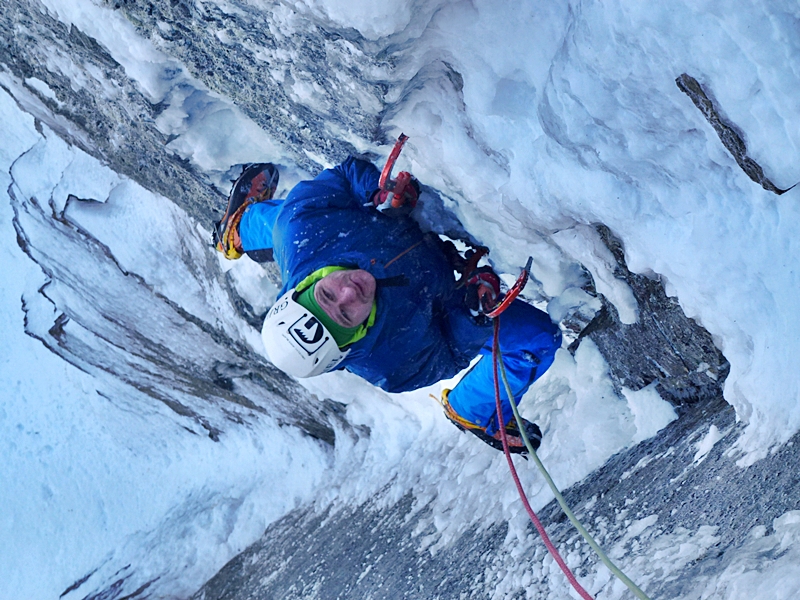
Guy Robertson seconding the first pitch of what became the route called Slenderhead, a three pitch VIII/8
Compacted snow, stomped by the boots of those already ahead had turned black. I thought back to the last time I climbed in Stob Coire nan Lochan two years ago. On that occasion, Guy Robertson and I fell behind Greg Boswell and Will Sim, but after a while we caught up with them, but only because they had stopped. The four of us stood together, taking in the blocky steepness. The wind stirred white devils and numbed fingers.
“Are you looking at the Beyond Good and Evil line?” Will said without taking his eyes from the thin streak of ice.
“Yes.” I replied.
“RACE YOU!” Greg shouted, sprinting toward the cliff. The deep snow hardly slowed him. His bouffant, not as wild and crazy as before, a million damp curls. Greg laughed between gulps and strides before laughing some more. We all laughed, even Robbo who takes this winter climbing game very serious.
After gearing up, Guy and I climbed the Beyond Good and Evil line, three pitches of varied, sustained climbing, and we call the new route Slenderhead. We almost became lost while walking from the top of the cliff in a white out. Eventually we reached our bags stashed by a large boulder in the base of the coire. We meet with Greg and Will who have also had a good day, both having led a route called The Tempest.
The Tempest was first climbed in 2001 by Neil Gresham using a style that I’m glad to say has not become popular:
“The Tempest was born from the desire to bring a slice of the continental style of mixed climbing home to Scotland. I had gained so much enjoyment and learned so many new skills from the ‘M’ routes in Canada and Europe and I couldn’t see why the UK shouldn’t also benefit, providing no bolts are placed and that winter conditions prevail. Needless to say, there were critics, but the winds are changing in mixed climbing. The Tempest remains an exciting and fiercely technical challenge for the open-minded.” Neil Gresham.
I have only met Neil once, several years ago, immediately warming to him. Neil was interesting and cheerful and pleasant; if I spent more time in his company I’m sure we would get along. I respect Neil completely for his rock climbs and his drive and ability, but in climbing The Tempest with the style he chose (a long time ago now I admit) I believe he was misguided. Scottish winter climbing is an adventure into the unknown, but if this type of ascent – repeatedly worked, pre-placed, hammered gear – was to become common, for how long?
Winter climbing in Britain is very popular and the numbers of climbers on the crags are increasing. Scottish, Welsh and Lakeland crags are small, and the on-sight, ground-up ethic that has been followed, almost without question from the beginning, lifts the worldwide reputation of our small cliffs. More importantly, top-roping, pre-inspection and pre-placed gear should have no place in winter climbing in Britain, not least because of the damage to flora and rock that would be caused by the increased number of climbers ready to take to the crags armed with sharp implements. If one climber can flout the rules why shouldn’t any climb of any grade be fair game? Those who influence the climbing community have a duty to strengthen and enhance the preservation of our ethics by providing good practice, and by this I don’t only mean the movers and shakers in the UK, but also climbers visiting from abroad. There have been occasions I know of where visiting climbers, who talk about how they relish our pure ethics, go on to disregard the on-sight, ground up approach, which in turn weakens the very thing they say they come for.
By nature of the ethics we apply to ourselves we naturally limit the damage to the cliffs, and in the long run this will preserve our being able to continue, because our crags are for everyone, not just climbers. If we are seen as flagrantly destroying plant life, animal habitation, the rock, the natural beauty, we will be shut down and rightly so. We apply the self-imposed regulations by showing restraint, which in turn enhances our experience and protects the cliffs. This shows integrity and is something of which we can be proud.
Britain now has on-sight ascents of climbs harder than The Tempest. The Tempest itself has now been climbed in good style after Andy Turner removed all of the in-situ gear left in place from the first ascent. Leaving the gear in the climb was an oversight because with time, this gear became untrustworthy, stopping anyone else from attempting it. Neil made the point that no bolts should be used, and I completely agree, but at least if bolts were used the climb would have been available for future attempts. The very fact that hammered, pre-placed gear was used suggests that this is a style of ascent is more suited to countries where bolts are used and not Scotland. Andy Turner had the inclination and generosity to remove all of the rotting gear and he should be commended, but it should never have come to that. Get to the top or return to the ground to try another day, or leave the challenge for someone else.
At Kendal Mountain Festival last November, I was presenting a talk about Scottish winter climbing with Andy Nisbet, Mick Fowler, Guy Robertson and Greg Boswell. I think we all had a great time and enjoyed the get-together and banter, but there was one thing that immediately reminded me of the day in Stob Coire nan Lochan.
Greg Boswell is without doubt a great friend. I respect Greg’s superior climbing ability, fitness and drive, but I respect his mature and laid back personality even more. My Grandad used to say, “You can’t put an old head on young shoulders”, but I’m not so sure. Greg and I get on well, we understand each other even though there is twenty five years between us. We have spent many a cold hour in both Scotland and Canada. And of course, we share an intense experience with THE BEAR. But Greg said something in the lecture at Kendal that shocked me a little given his attitude towards winter ethics: “To advance the sport we need, at times, to bend the rules.” These may not be the exact words used, but this was the meaning and he definitely did say ‘to advance the sport’.
This reminded me of what I thought Greg was against, especially since the day both Will and Greg on-sighted The Tempest, Neil said, “The Tempest remains an exciting and fiercely technical challenge for the open-minded”. Climbed as Neil did, what The Tempest became is a fiercely technical challenge taken away from someone with the ability to successfully climb it in the style agreed upon by the general climbing community. And in doing this, the unique and untainted experience which comes from making a first ascent is lost, along with being credited in journals and guide books. The phrase it’s there for someone to improve upon is perhaps used too frequently by climbers who are impatient or selfish, as an excuse for poor practice. Once a new route is climbed it will never again be a new route, it will have lost mystique, the unknown, the ultimate challenge.
“British climbers will fall behind in standards if we don’t have the really hard technical bolted climbs of abroad or we only on-sight” is an argument I have heard over the years, and I think it is similar to what Greg was meaning by “to advance the sport.” Well, call me a dinosaur (something Greg does often) but I’m not sure pushing grades by whatever means really matters. Who cares about grades? Scottish winter climbing is not a competition, we don’t need to make bigger numbers, it doesn’t advance the sport, because winter climbing is not a sport. Winter climbing does not need to be advanced, if climbing bigger numbers is what is classed as advancing. I would say we advance by keeping the activity honest; we should give the cliffs a chance. For me and for many like me, the big adventure is brought about by the rules we place on ourselves, it is this that makes winter climbing in Britain special and different. Winter climbing should be hard, cold and uncomfortable. Winter climbing should be uncertainty at whatever level, it should be breaking down mental boundaries and pushing on, or knowing when to say enough is enough and retreating. Winter climbing should be shafts of light cutting through the grey clouds. Shimmering ice locked lochs. The pain and the heat of hot aches. An approach in the dark and (often) a decent in the dark. Close contact with nature. An unforgettable experience. Winter climbing in Britain should not be the number chasing activity that can be found almost anywhere else in the world.
However, winter climbing is advancing, and this advancement is almost organic, brought about through better gear and training, and yes, the ability to jump on a plane to go places like Kandersteg, The Alps or Canada, which gives us an ever-increasing appreciation of what is possible. And because of this, there are more climbs being opened at the top of the grade using traditional ethics.
A few mornings ago, I read something in the Guardian that reminded me of a conversation I had in the climbing wall which relates to what I have written here. The Guardian piece was an interview with Brian Eno, and written by Simon Hatterstone. Eno, asked about the political impact of Brexit and Trump in 2016 says, “Actually, in retrospect, I’ve started to think I’m pleased about Trump and I’m pleased about Brexit because it gives us a kick up the arse [ … ] now, with Trump, there’s a chance of a proper crash, and a chance to really rethink.” I don’t agree with Eno, as I think Trump as President is far too big a risk, but after talking to friends in the climbing wall about winter climbing ethics I came round to a similar notion, that by having someone take the risk and throw the rule book away, on occasion, is needed for continued debate, which will then either confirm and strengthen what we have in place or radically change it. So with this in mind, I’d like to say an honest thanks to Neil for being bold in going against the ethics and to Greg for getting me to think about what he said, which led me to write this piece. And in writing this, I hope it will strengthen what we already have in place, which is something to be proud of and worth safeguarding. But if it turns out what we have is outdated, clung to by dinosaurs, so be it.

Matt Helliker climbing the first pitch of East Face Direct, Direct, 2017. Slenderhead starts on the left and the top corner pitch of the Direct, Direct, shares the same final belay as Slenderhead.


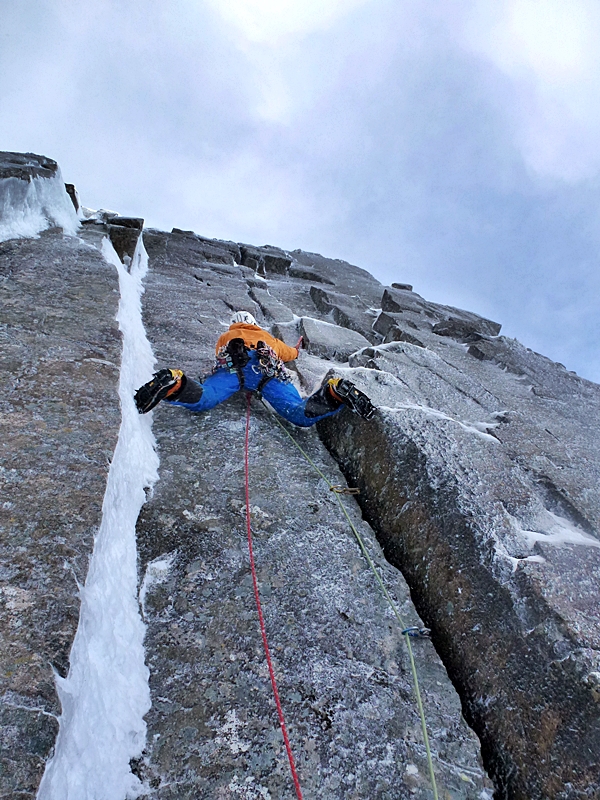
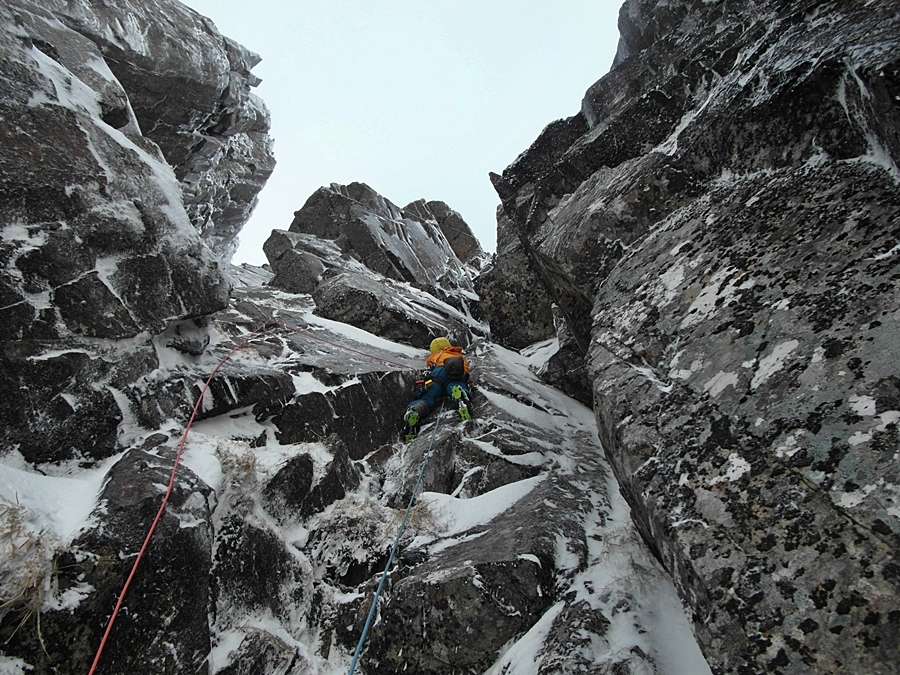
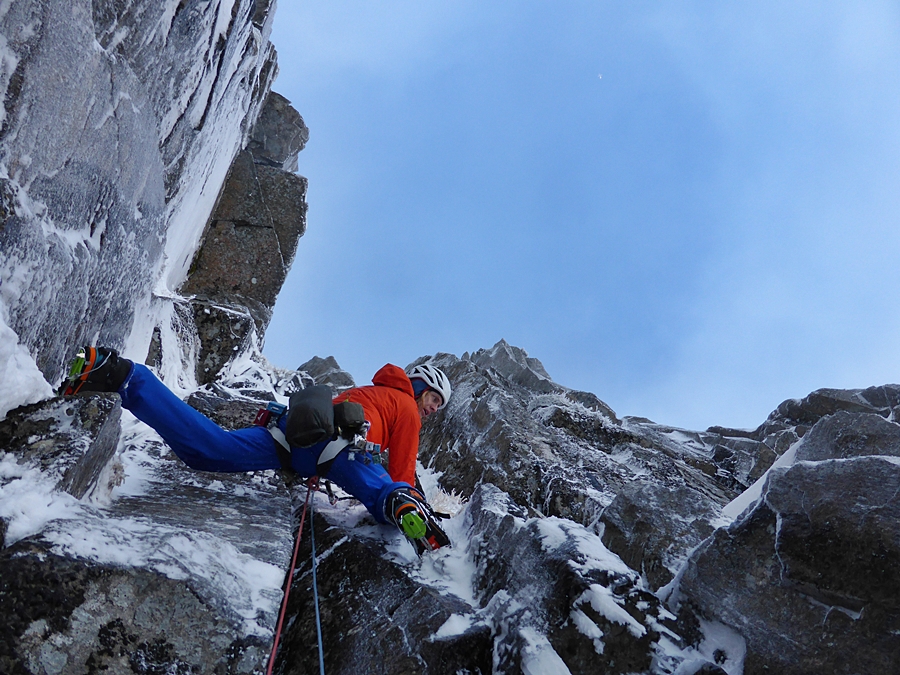
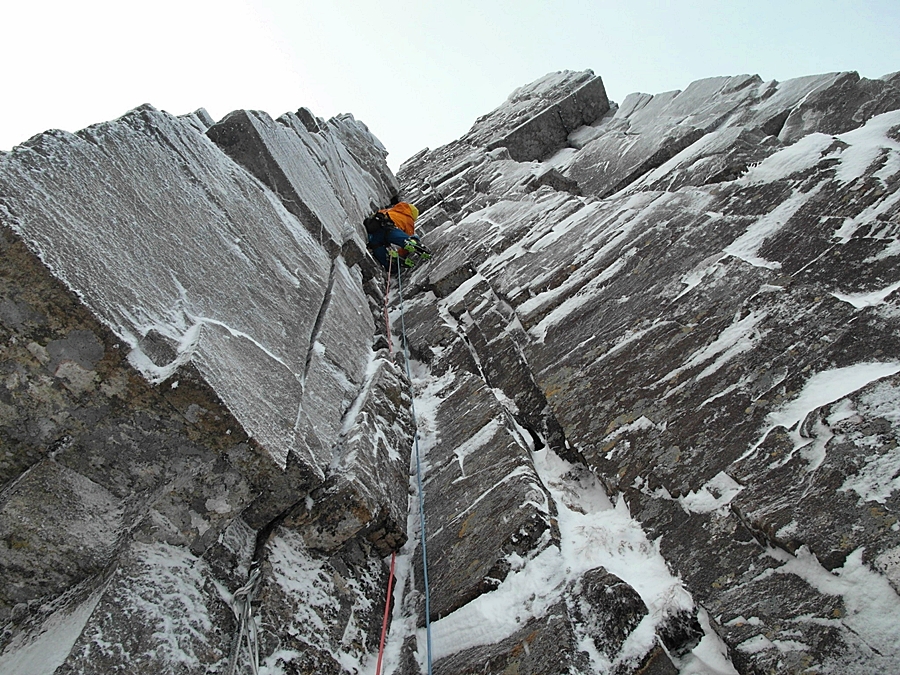







There was me reading away, sub-consciously thinking up my counter-reply and then I get to the last paragraph and it suddenly fizzles out (my reply that is!).
“The wise man looks for the truth, the idiot’s already found it.” There’s obviously no hope left for the Gob, but it sounds like the Bullock might be softening a little!
And that photo of Slenderhead… could almost have me dusting off my Nomics!
Did he go left or right?
Ha, nice one Neil. He went right! 🙂
Thanks Nick,
You advance not a dinosuar’s pov, but a mature perspective on the nature of the sport.
There are no compelling arguments for grade fetishism, and i also recall no well constructed deliberations on what ‘advancing the sport’ amounts to (beyond grade fetishism) or indeed why this would be desirable.
This is not an argument against climbing harder (although, it’s interesting to note that no arguments are necessary to promote this desire), rather just a reasonable desire for us to stay rooted in balanced consideration of what ascending a Scottish winter route consists in. And as we all know, that bears on a great deal more than just two numbers.
Thanks for all your efforts mate.
John Cuthbert